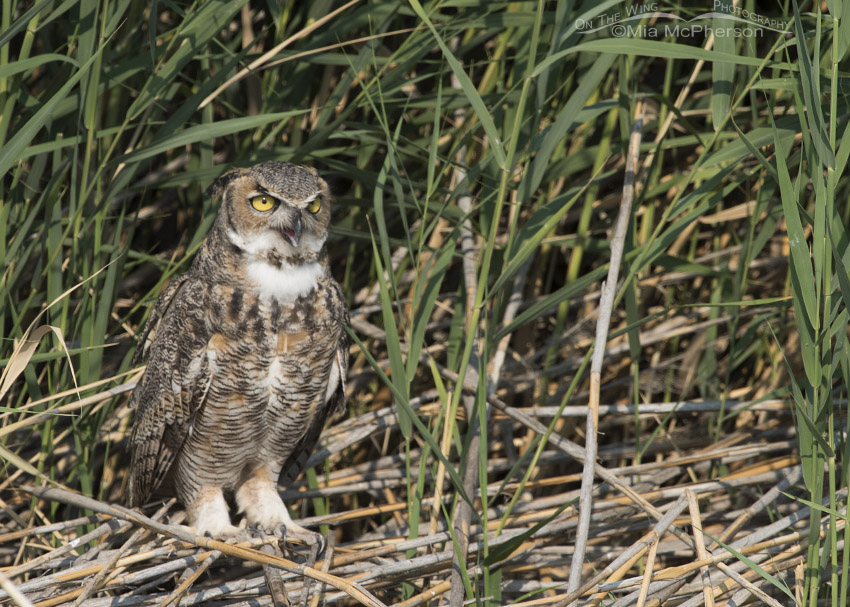 Great Horned Owl in the marsh at Bear River MBR – Nikon D810, f7.1, 1/1250, ISO 400, -0.7 EV, Nikkor 500mm VR with 1.4x TC, natural light, not baited
Great Horned Owl in the marsh at Bear River MBR – Nikon D810, f7.1, 1/1250, ISO 400, -0.7 EV, Nikkor 500mm VR with 1.4x TC, natural light, not baited
Yesterday I posted a sleepy Great Horned Owl photographed fours years ago in Montana and what I didn’t mention is that I don’t get many opportunities to photograph these large owls very often, sometimes it only happens once or twice a year.
But yesterday I saw a Great Blue Heron out in the open in the marsh of Bear River Migratory Bird Refuge on the south side of the auto tour route. For a split second I looked down at my camera to check my settings and when I looked back up the heron was gone. I felt some disappointment but thought maybe the heron had just moved a little and because of that I kept my eye out for it further up the road. Just a little bit further up the road I saw a shape, feather patterns and face that I recognized immediately but it wasn’t a heron at all.
What I found was a beautiful Great Horned Owl nearly hidden in the vegetation along the marsh! I’d never seen a Great Horned Owl at Bear River wetlands before so I was ecstatic and took way too many photos of it but it isn’t every day I spot this species of owl in a marsh, so why not?
I have that Great Blue Heron and my keen eyesight to thank for finding the owl because if it hadn’t been for it and trying to locate it again I might not have been paying such close attention to the area I found this owl in. Thanks Great Blue!
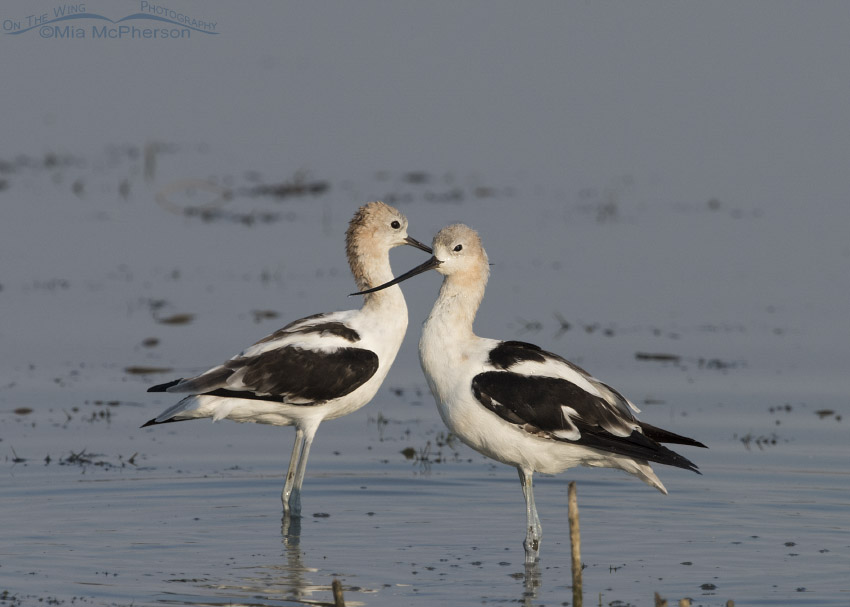 Two American Avocets at Bear River MBR – Nikon D810, f7.1, 1/2000, ISO 400, Nikkor 500mm VR with 1.4x TC, natural light
Two American Avocets at Bear River MBR – Nikon D810, f7.1, 1/2000, ISO 400, Nikkor 500mm VR with 1.4x TC, natural light
Now onto my main subjects for this post. Before finding the Great Horned Owl I was photographing shorebirds at the southwest corner of the auto tour route on the refuge. I saw two American Avocets close to each other and decided to take a few shots of them even though I didn’t think much of the setting because it looked messy but the light was good and I had willing subjects.
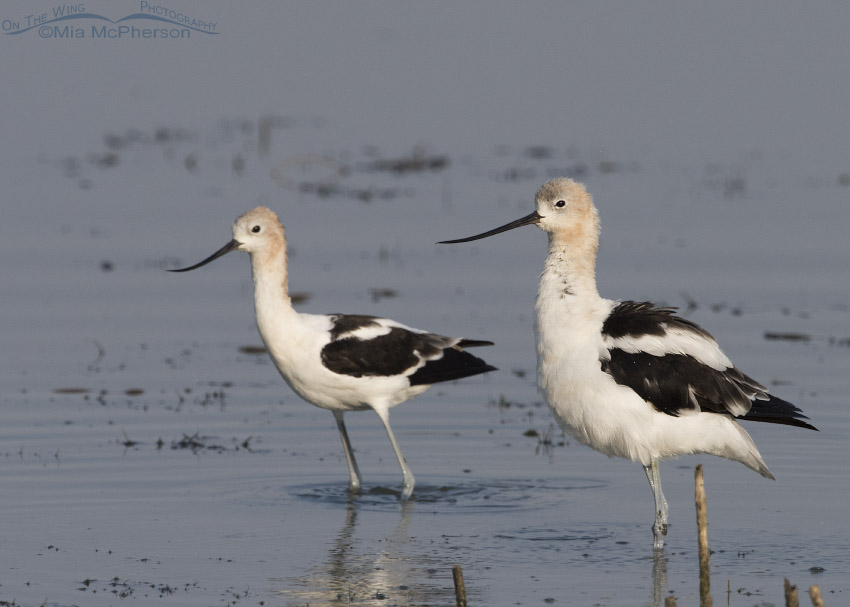 Male American Avocet Fluffs up – Nikon D810, f7.1, 1/2000, ISO 400, Nikkor 500mm VR with 1.4x TC, natural light
Male American Avocet Fluffs up – Nikon D810, f7.1, 1/2000, ISO 400, Nikkor 500mm VR with 1.4x TC, natural light
When I saw the male fluff up his feathers I thought I might get a nice wing lift because avocets often do that after they shake their feathers so I kept my focus on him.
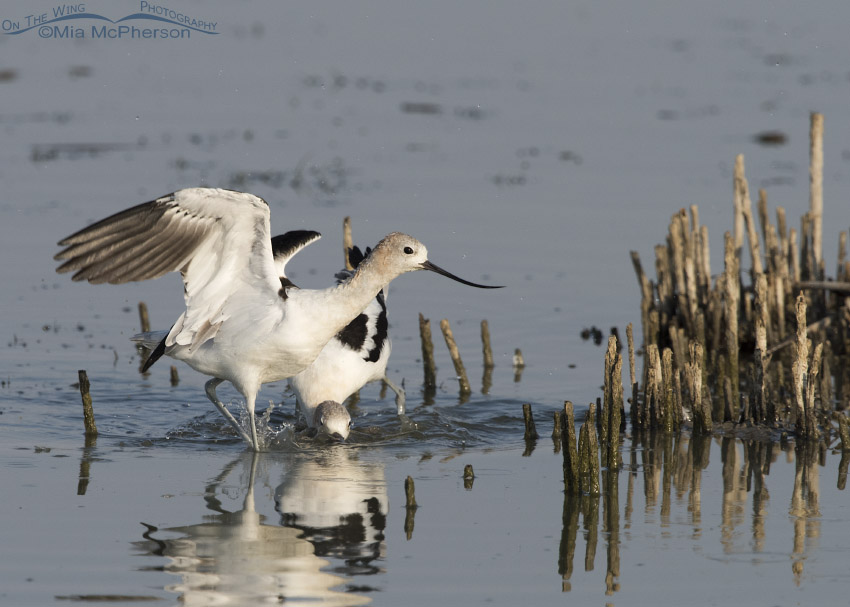 American Avocet gets aggressive – Nikon D810, f7.1, 1/2000, ISO 400, Nikkor 500mm VR with 1.4x TC, natural light
American Avocet gets aggressive – Nikon D810, f7.1, 1/2000, ISO 400, Nikkor 500mm VR with 1.4x TC, natural light
The male placed his head in the water instead and the female lifted her wings and moved in front of the male. The behavior wasn’t typical for this time of the year so I kept photographing the pair of avocets.
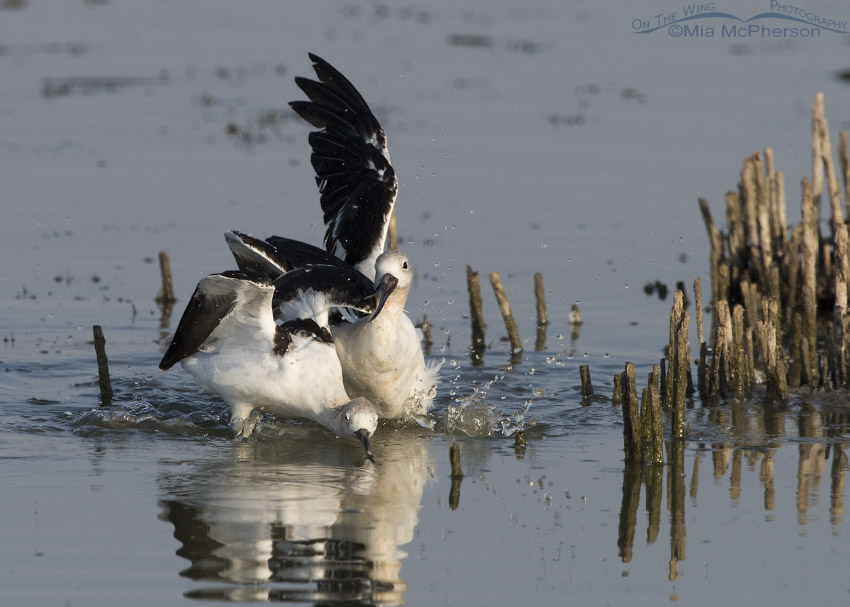 One American Avocet attacking the other – Nikon D810, f7.1, 1/2000, ISO 400, Nikkor 500mm VR with 1.4x TC, natural light
One American Avocet attacking the other – Nikon D810, f7.1, 1/2000, ISO 400, Nikkor 500mm VR with 1.4x TC, natural light
And then the male American Avocet began to attack the female. You can see his bill open near her left wing but he didn’t grab or stab her wing…
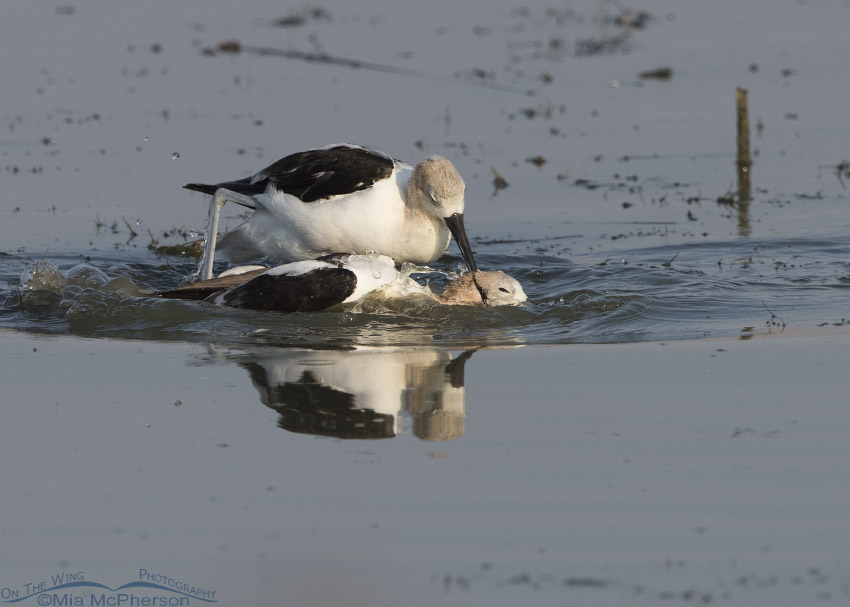 American Avocet pinning down the other – Nikon D810, f7.1, 1/1600, ISO 400, Nikkor 500mm VR with 1.4x TC, natural light
American Avocet pinning down the other – Nikon D810, f7.1, 1/1600, ISO 400, Nikkor 500mm VR with 1.4x TC, natural light
Instead he wrapped his bill around the female’s neck and used it to pin her head down and get the upper hand in his attack.
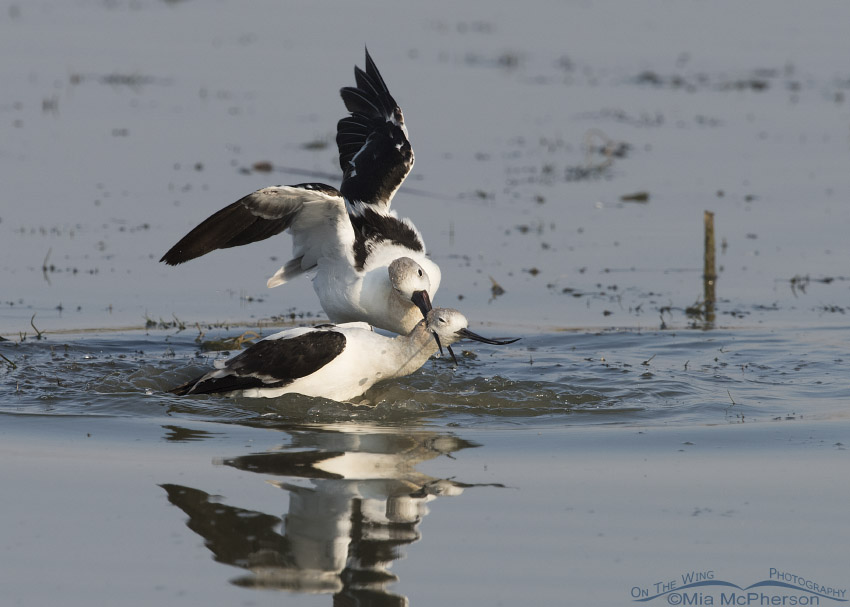 Male American Avocet with a grip on the female’s neck – Nikon D810, f7.1, 1/1600, ISO 400, Nikkor 500mm VR with 1.4x TC, natural light
Male American Avocet with a grip on the female’s neck – Nikon D810, f7.1, 1/1600, ISO 400, Nikkor 500mm VR with 1.4x TC, natural light
It appeared that the female struggled against the aggressive behavior of the male but he was the one who seemed determined to keep the power…
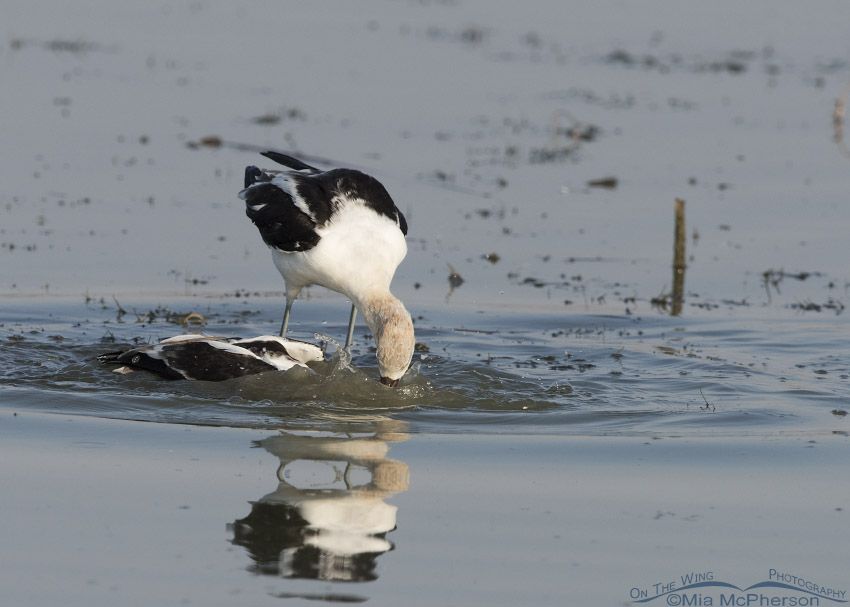 Male American Avocet pushing the female under water – Nikon D810, f7.1, 1/1600, ISO 400, Nikkor 500mm VR with 1.4x TC, natural light
Male American Avocet pushing the female under water – Nikon D810, f7.1, 1/1600, ISO 400, Nikkor 500mm VR with 1.4x TC, natural light
And the male American Avocet pushed the female’s head under the water and held it there and shook his bill side to side.
All during the time that this was taking place I hadn’t determined the sexes of my subjects, I was too focused on capturing the action, I didn’t pay any attention to the sexes until I got home and viewed these images.
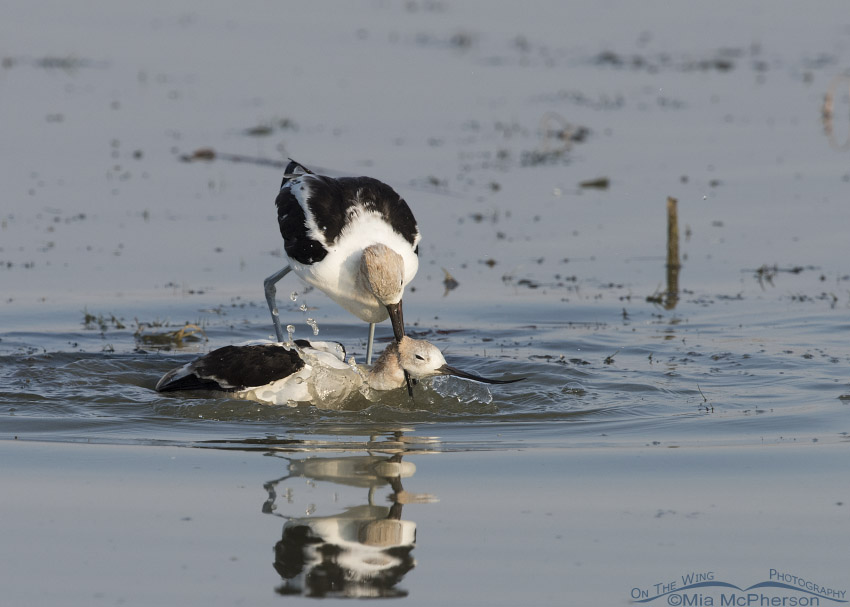 Male American Avocet choking the female – Nikon D810, f7.1, 1/1600, ISO 400, Nikkor 500mm VR with 1.4x TC, natural light
Male American Avocet choking the female – Nikon D810, f7.1, 1/1600, ISO 400, Nikkor 500mm VR with 1.4x TC, natural light
When the female’s head came up above the water it was easy to see that the male still had what appeared to be a very strong grip on the female’s neck.
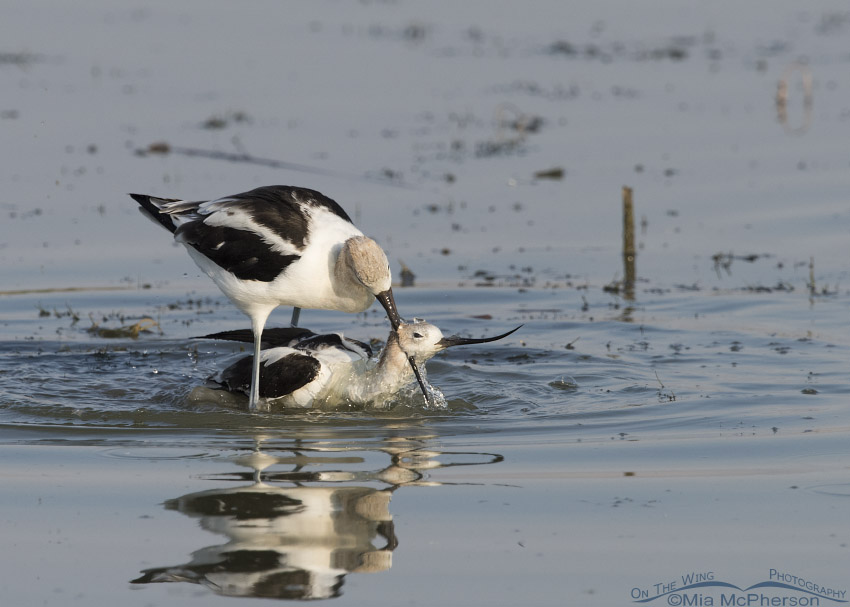 Male American Avocet being aggressive with the female – Nikon D810, f7.1, 1/1600, ISO 400, Nikkor 500mm VR with 1.4x TC, natural light
Male American Avocet being aggressive with the female – Nikon D810, f7.1, 1/1600, ISO 400, Nikkor 500mm VR with 1.4x TC, natural light
And he kept that grip as her head shook around. I don’t know if she was moving her head or if he was moving his bill as part of his aggression.
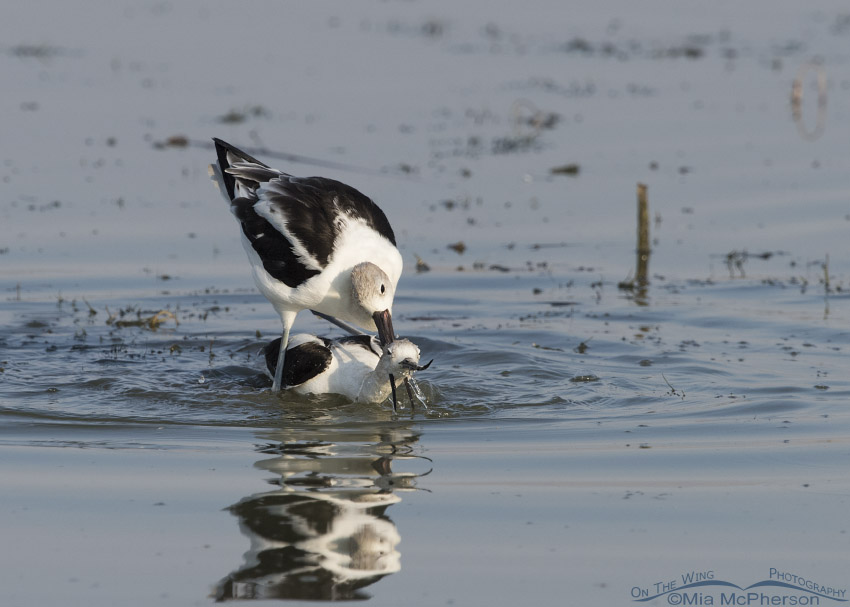 American Avocet male with his bill around the female’s neck – Nikon D810, f7.1, 1/1600, ISO 400, Nikkor 500mm VR with 1.4x TC, natural light
American Avocet male with his bill around the female’s neck – Nikon D810, f7.1, 1/1600, ISO 400, Nikkor 500mm VR with 1.4x TC, natural light
But the male American Avocet kept attacking the female with his bill.
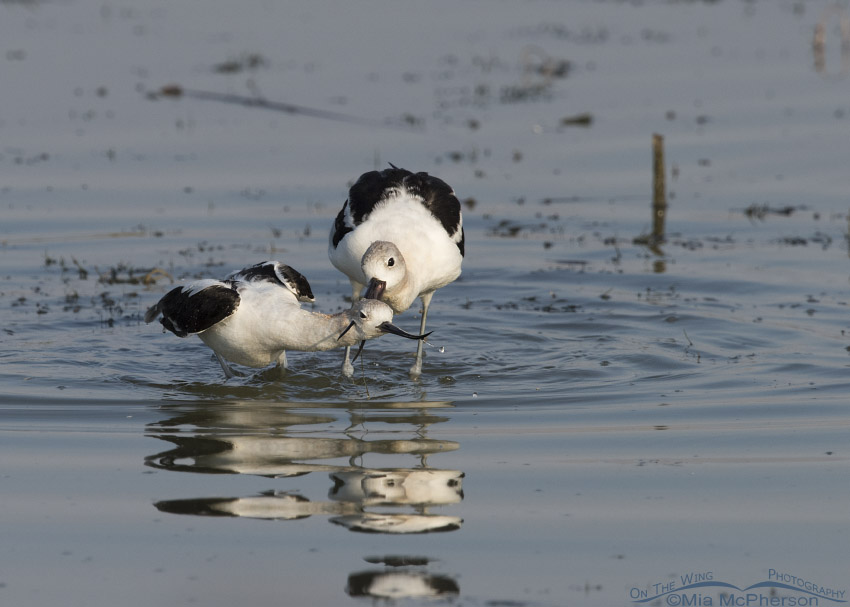 End of American Avocet battle – Nikon D810, f7.1, 1/1600, ISO 400, Nikkor 500mm VR with 1.4x TC, natural light
End of American Avocet battle – Nikon D810, f7.1, 1/1600, ISO 400, Nikkor 500mm VR with 1.4x TC, natural light
The female was able to stand up and lifted her body out of the water even while the male continued to grasp her neck. Right after this image was taken the female pulled away from the male, he lost his grip on her neck and the two avocets parted ways and the female moved several feet away from the male.
Then they both went back to foraging for food.
Quite frankly I don’t know what this aggressive behavior was about. From what I read on Birds of North America online is that physical interactions are common during the winter and early spring and tend to be associated with pairing. But the breeding season for American Avocets is over here now in Northern Utah so I am not inclined to think this was about pairing up. I am unable to find information on line about why this male American Avocet attacked the female so aggressively but I can say that it was fascinating to see and photograph it.
If any one can tell me what this degree of aggressive behavior in American Avocets was about outside of the breeding season I would love to know!
I never know what I am going to see when I go out into the field and that is one small part of why I am so passionate about photographing birds.
Birds are fascinating. Life is good.
Mia
Click here to see more of my American Avocet photos plus facts and information about this species. Click here to view more of my Great Horned Owl photos plus facts and information about this species.


Interesting post. Now I have another bird to watch for at the Bear River refuge. As for the aggressive male, maybe he has too much testosterone or just felt the need to practice his moves. Little morality in nature.
Found this online: “Aggressively defensive behavior in large colonies of avocet has earned them the name “Avocet:Exocet” from the British bird watchers.”
Wow, that’s fascinating and surprising behavior. It’s not something I’ve ever seen. Nice job documenting the behavior. Like you, I’d be curious to know more. Nature always has something new to show us. And, of course, nice find with the Great Horned Owl.
Ack. I hope she got well away. That looked just plain nasty.
So much we don’t understand. As always, thanks for sharing.
Could be a food aggression behavior. There are many birds on the refuge right now perhaps less available food. Some individual birds are just plain aggressive too.
If I were a female, pairing or not, I wouldn’t hang around that guy anymore. I generally think of avocets as being statuesque and graceful and this kind of behavior seems so violent. The other impressive thing is that this type of behavior has not been documented previously. Great work! John
Wow. Even if they do that in breeding season, how is that romantic? If the females mate with males because of how mean they are, they are setting themselves up to be domintated. I don’t get it, but female humans live with abusers, too, and say, “but I love him,” and I don’t get that, either.
Looks like domestic abuse to me !!! A bully is a bully! Glad she got away and wasn’t drowned. I know It happens….certainly interesting behavior to witness, whatever it was….(glad you’re feeling better. 🙂 )
Beautiful photos, Mia. One of natures Mysteries.
Great to read and nice pictures .